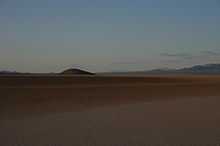Delamar Dry Lake
| Delamar Lake Landing Strip | |||
|---|---|---|---|
| IATA: none – ICAO: none | |||
| Summary | |||
| Coordinates | 37°19′13.87″N 114°56′55.03″W / 37.3205194°N 114.9486194°WCoordinates: 37°19′13.87″N 114°56′55.03″W / 37.3205194°N 114.9486194°W | ||
| Map | |||
 Delamar Lake Landing Strip | |||
| Runways | |||
| Direction | Length | Surface | |
| ft | m | ||
| 15,000 | 4,572 | unpaved dry lakebed | |


Delamar Dry Lake is a dry lakebed located in the Dry Lake Watershed near Alamo in Lincoln County, Nevada.[1] The lakebed is located on federal land administered by the Bureau of Land Management.
Delamar Dry Lake Landing Strip
Delamar Lake Landing Strip, established in 1943, was designated as an emergency landing site for the X-15. No structures were built there. The lake bed remains but it is no longer maintained as an airport.
Delamar was listed as having one runway:
- Runway 15,000 feet, Surface: unpaved dry lakebed[2]
However, on a dry lake bed an aircraft may actually land in any direction.
History
Delamar Lake Landing Strip was one of the designated emergency landing sites for the X-15 because it was underneath the Delamar Dry Lake Drop Zone where the X-15s were drop-launched from the B-52 for high altitude and space flights.[3]
On May 21, 1962, X-15 pilot Neil Armstrong (later a Gemini and Apollo astronaut) flew an F-104 to Delamar Dry Lake in case it would be needed for an upcoming X-15 flight. The F-104 was damaged in the landing attempt at Delamar when the landing gear began to retract. Armstrong got the plane back in the air and diverted to Nellis AFB in Las Vegas.
During Flight 1-63-104 on May 6, 1966, an X-15 experienced an engine failure and landed at Delamar Dry Lake.[4][5]
The US Air Force now refers to Delamar Dry Lake Bed as "Texas Lake" because of its resemblance to the state of Texas from the air. [6]
An eyewitness report regarding the Space Shuttle Columbia disaster came from a camper who was at Delamar Dry Lake on the morning of February 1, 2003. The eyewitness saw the space shuttle cross the pre-dawn sky, as well as a bright flash in the contrail. Minutes later, the camper saw two "twinkles" descend into mountains perceived to be nearby. NASA considered this report credible enough to analyze radar data and send a ground search crew to the area to look for debris. None was found.[7]
See also
- Delamar, Nevada - nearby ghost town
- Delamar Mountains
References
- ↑ "Delamar Lake". Geographic Names Information System, U.S. Geological Survey. Retrieved 2009-05-04.
- ↑ aerofiles
- ↑ Wade, Mark. "Delamar Dry Lake DZ". astronautix.com. Retrieved 2008-08-17.
- ↑ airfields-freeman.com (southern NV)
- ↑ airfields-freeman.com (northeastern NV)
- ↑ ( USAF Mishap Report 72-1221-2 21-DEC-72)
- ↑ "NASA Early Sighting Assessment Team (ESAT) Final Report (appendix to CAIB Final Report)" (PDF). Columbia Accident Investigation Board (CAIB). 2003-06-03. pp. pages 131–135. Retrieved 2008-03-04.
External links
- Delamar experimental rocket launch - recurring high power rocketry launch by Tripoli Las Vegas
- Crew Space Transportation (CST)-100 Parachute Drop Test at Delamar, gallery by BLM